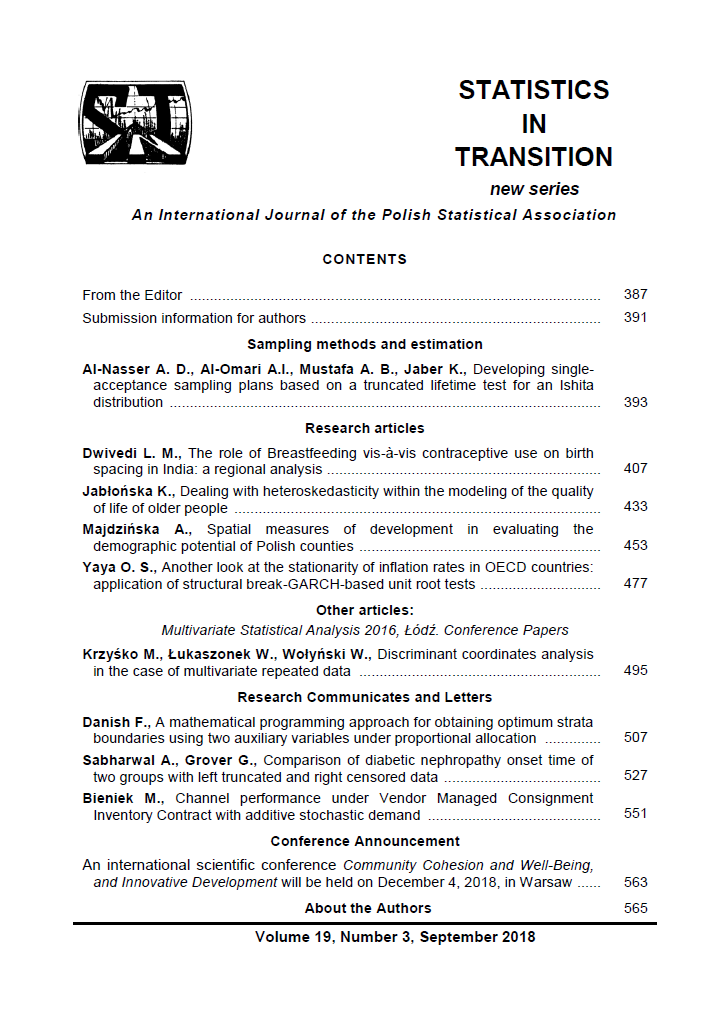ARTICLE
ABSTRACT
Acceptance sampling plans are statistical procedures that are used for quality control and improvement in cases where it is not possible to test every item in a lot of materials. The outcome of this test determines whether the entire lot is accepted or rejected based on a random sample. In this procedure, an important characteristic of the materials is their lifetime sampling distribution, and this can vary from sample to sample. In this article, a new lifetime distribution, known as an Ishita distribution, is considered for developing a new single-acceptance sampling plan. The new acceptance sampling plan is developed under a condition wherein the mean lifetime test is truncated within a pre-specified time period. Based on this condition, the parameters of the acceptance sampling plan including the operating characteristics function and the minimum sample size are obtained. The producer's risk in relation to the entire lot of materials is derived and illustrated by numerical examples
KEYWORDS
acceptance sampling plans, Ishita distribution, producer's risk, consumer's risk, operating characteristics, truncated lifetime-distribution test.
REFERENCES
AL-NASSER, A. D., AL-OMARI, A. I., (2013). Acceptance sampling plan based on truncated life tests for exponentiated Frechet distribution. Journal of Statistics and Management Systems, 16 (1), pp. 13–24.
AL-NASSER, A. D., GOGAH, F. S., (2017). On Using The Median Ranked Set Sampling for Developing Reliability Test Plans Under Generalized Exponential Distribution. Pakistan Journal of Statistics and Operation Research, 13 (4), pp. 757–774.
AL-OMARI, AI, AL-NASSER A. D., GOGAH, F. S., (2016a). Double Acceptance Sampling Plan for Time-Truncated Life Tests Based on Half Normal Distribution, Economic Quality Control, 31 (2), pp. 93–99.
AL-OMARI, A. I., AL-NASSER, A. D. , GOGAH, F. S., (2016b). Double acceptance sampling plan for time truncated life tests based on transmuted new Weibull-Pareto distribution. Electronic Journal of Applied Statistical Analysis, 9 (3), pp. 520–529
AL-OMARI, A. I., (2015). Time truncated acceptance sampling plans for generalized inverted exponential distribution. Electronic Journal of Applied Statistical Analysis, 8 (1), pp. 1–12.
ASLAM, M., JUN, C. H., AHMED, M., (2011). New acceptance sampling plans based on life tests for Birnbaum-Saunders distributions. Journal of Statistical Computation and Simulation, 81 (4), pp. 461–470.
BAKLIZI, A., E. L. MASRI, A., (2004). Acceptance sampling based on truncated life tests in the Birnbaum Saunders model. Risk Analysis, 24 (6), pp. 1453–1457.
BALAKRISHNAN, N., LEIVA, L., LOPEZ, J., (2007). Acceptance sampling plans from truncated life tests based on the generalized Birnbaum-Saunders distribution. Communications in Statistics – Simulation and Computation, 36,pp. 643–656.
GOGAH, F. S, AL-NASSER, A. D., (2018). Median Ranked Acceptance Sampling Plans for Exponential Distribution. Afrika Matematika, 29 (3-4), pp. 477-497. https://doi.org/10.1007/s13370-018-0555-7.
GUPTA, S. S., GROLL, P. A., (1961). Gamma distribution in acceptance sampling based on life tests. Journal of American Statistical Association, 56, pp. 942–970.
KAO, J. K., (1966) “Single sample attri-variate plans for item variability in percent defective,” Annual Technical Conference Transactions of the American Society for Quality Control, New York, NY, USA, pp. 743–758.
KANTAM, R. R. L., ROSAIAH, K., RAO, G. S., (2001). Acceptance sampling based on life tests: log-logistic model. Journal of Applied Statistics, 28, pp 121–128.
STATISTICS IN TRANSITION new series, September 2018 403
SHANKER, R., SHUKLA, K. K., (2017). Ishita distribution and its applications.Biometrics & Biostatistics International Journal, 4 (7), pp. 1–9.
SHUKLA, K. K., SHANKER, R., (2018). Power Ishita distribution and its application to model lifetime data. To appear in Statistics in Transition new series, 19 (1).
